-
Know about the contribution
of the Maharanas of Mewar towards water conservation, preservation and distribution,
which they achieved by building numerous lakes.
- They implemented traditional
techniques of water conservation by using their self-created water bodies.
- Merging of canals
with rivers and inter linking of rivers are some innovations.
A significant
tradition of the ‘Suryavanshis’
(Solar Dynasty) comprises long lineage of being ruled by famous Rulers who have
contributed immensely towards human welfare on Earth.
The social order
established by Manu proved beneficial for the entire human race. Scriptures
hail Ikshvaku, son of Manu as a glorious and righteous monarch whose grandeur
dominated all four directions on Earth to an extent that for centuries to come the
Solar Dynasty was popularly referred to as Ikshvaku Dynasty.
One of the descendants
of Ikshvaku Dynasty was the legendary King Bhagirath, son of King Dilip. Bhagirath
performed penance and worshipped Goddess Ganga with the purpose of providing
salvation to his ancestors and welfare of the entire Universe. This practice
led to the descent of Goddess Ganga from Heaven to Earth in the form of the sacred
River Ganges. Emergence of the Ganges on Earth was a boon resulting in all
round development and progress of the entire Universe.
Picking up from
here the kings of Solar Dynasty of Gohil lineage, who forever continued to
serve society. Various important projects related to human welfare were started
by them. The efforts of the Solar Dynasty flourished, commanding respect from contemporary
rulers all around, thus they managed to make Mewar as one of the strongest and
most powerful states of the era.
Rulers of Mewar,
during their respective reigns, made individual efforts to undertake, implement
and successfully complete activities of sustainable management of natural
recourses of fresh water to meet their current and future demands.
Udaipur, which
is world famous as, ‘The City of Lakes’ is
one of the finest examples of protection
of hydrosphere where the lakes of the city are
interconnected to form a lake
system which supports and sustains ground water recharge, ensuring availability
of water for the purpose of - consumption, industries, agriculture and tourism.
Apart from this, the
Maharanas of Mewar have contributed immensely towards universal unity, patriotism,
independence, dedication, devotion, sacrifices and issues of social and
economic welfare for the betterment of common man. The unparalleled
contribution of the Maharanas of Mewar for the continuous service, development
and all round progress by meeting the day-to-day requirements of people in
different parts of the state placed them on a high pedestal.
Traditional
methods of conservation and management of water by the Maharanas of Mewar has set an
unprecedented global example presenting themselves as role models in the field
of water conservation and management. The Maharanas not only guarded and
protected the territories of their state from invaders but also contributed
largely towards governance of rain water to meet the essential requirement of
water supply during war and drought.
Note that all dams were made for irrigation and water supply not for beautification. Also, dams were always made between two hillock's at either end.
Maximum methods of
natural water harvesting and harnessing in Mewar region is in the form
of lakes, ponds, dams, step-wells and canals, built by the Maharanas of Mewar.
Format is title of
lake, who built in, period of rule by Maharana, picture of lake and below that
information about lake. Major lakes title in purple, smaller in blue.
1. Lake
Udai Sagar built by Maharana Udai Singhji, ruled
1537-1572.

He established Udaipur
as the new capital of Mewar. Along with that he also got a dam constructed on River
Ayed that resulted in a lake that was named after him. The completion of this
lake took approximately 5 years, between (1569-1564 CE).
Flowing 6 miles
east of Udaipur this lake is 2.5 miles long and 2
miles broad. The first time it reached
its full capacity was in the year 1564.
The prime reason
for the construction of this dam was the security of the newly instated capital,
Udaipur as well as to ensure substantial water supply for irrigation and
personal consumption.
2. Lake Rajsamand built by Maharana Raj Singhji, ruled 1653-1680.
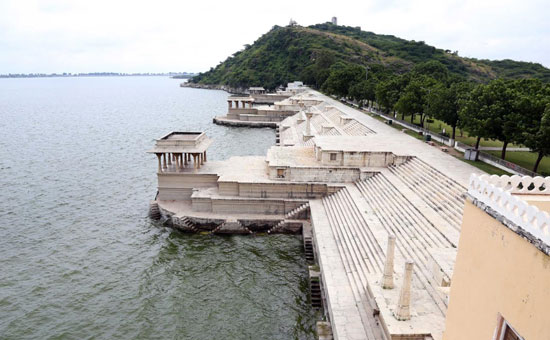
Raj Samudra also
known as Lake Rajsamand is an exquisite example of a water body. While still a
bachelor, Maharana Raj Singhji went to Jaisalmere for his wedding and saw the
possibility of lake at this place.
In 1661, he made a
halt to worship Shri Roopnarayanji, when he conceptualized the idea of
constructing a huge water reservoir near village Kankroli as a relief project
for the common man. Its enormity can be imagined by the fact that it embraces the
boarders of almost 12 villages in its circumference.
In 1662
CE the excavation for the foundation of this enormous
lake started simultaneously in square formation at different places. Various departments
were appointed to monitor this mammoth task. On April 17 1665 CE, Ranchod Rai
son of the royal priest Garibdas laid its foundation stone along with five gems.
On June
30 1671 CE proved to be the year of drought. ‘Pakhals’ (leather water pouches) were used to collect water from
various nearby places to fill the lake. Thereafter, an auspicious time for
boating was announced.
By 1673 CE reasonably
good rainfall was registered that managed to raise the water level of the lake
to about 8 feet. Skilled artisans from Lahore, Gujrat and Surat prepared water boats
that were cast in the lake on July 27, 1674 and the inaugural celebration of
the lake commenced in 1675.
The Maharana
observed fast on ‘Ashtami’ (eighth
day of the lunar calendar) and on ‘Navmi’
(ninth day of the lunar calendar) he reached the ‘mandap’ (covered structure with pillars temporarily erected to
perform prayer ceremony) near the lake to worship Lord Varun (Rain God) along with
his family, feudal lords, statesmen, other nobles and priests.
9 ‘kunds’ (a center place in the mandap
where fire is lit and oblations are made) were made in two separate mandaps and
the ‘yagna’ (Vedic sacrifice or
ritual worship) – ‘havan’ (sacred
fire) were performed.
Next
day, the Maharana accompanied by his family set out bare feet to take ‘parikrama’ (ritual of moving clockwise around
an object of devotion as an indication of reverence) of the lake; led by the
royal priests and Brahmins chanting the Vedas. Distance of 14 kos, (equal to
about 44.8 kms), was covered in 5 days that culminated on ‘Purnima’ (full moon day).
The
lake was formally inaugurated by offering ‘purnahuti’
(ceremony symbolizing of complete offering away of oneself).
Thereafter,
the Maharana performed gold ‘tula-daan’ (a ritual where a sacred donation is made by weighing it against the weight of the person performing it) in which he also weighed his grandson, Amar Singh with himself. Total of 12,000 tolas (approximately12 kgs.) of gold was donated that day.
As per Rajsamudra
inscription ‘Saptsagar’ was also donated on the same day. Queens, accompanied
by priests joined in to offer silver tula-daan.
The Maharana then presented 12 villages to the royal priest Garibdas; to the other
Brahmins he presented - villages, gold, silver etc. Priests Charan and Bhatt
(bards) were given Elephants, Horses, clothes etc.
This
significant occasion was commemorated by the presence of kings and nobles of
various states. Valuable gifts of Elephants, Horses etc. were exchanged between
them and the Maharana, as a mark of friendship.
About
46,000 Brahmins and locals were fed and clad that day. Total expenditure was
approximately Rs. 1,05,07,608.
On the
Nauchoki dam of this magnificent lake embankment, 25 artistically carved and engraved
colossal rocks bear inscription of 25 ‘sarg’ (cascade) of the great genre- ‘Rajprashasti, describing the glorious past of Mewar. These stone inscriptions are believed to be the longest engravings in the history of the country. This extraordinary masterpiece was created by Ranchod Bhatt, a Teleng by cast from Kathodi lineage. Credit for getting it engraved on the rocks goes to Maharana Jai Singhji, r. 1680 – 1698.
Names of the architects who made Rajsamand Lake are Mukund, Dalpati
Maha Singh, Mokum Singh and Vyaghra. There were four architects because it took
twelve years to make, in between some died.
3. Lake Jai Samudra or Jaisamand built between 1686-1691 CE by Maharana Jai Singhji.
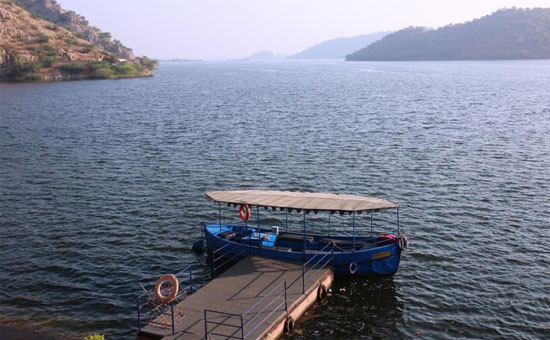 Pic gives a sense of lake size.
Pic gives a sense of lake size.
32
miles to the southeast of Udaipur is located the world famous man made, sweet
water lake, Jai Samudra.
When full,
it covers an area of more than 7 miles in length
and 6 miles in width. There are 3 islands on the lake, two are known as Baba
ka Magra while the third one is known as Pairi.
A marble dam approximately 1,000 feet long, 95 feet high and 50 feet broad at the base, exists between two hillocks. A similar dam measuring 1,300 feet exists behind this dam. Six exotic cenotaphs flank the lake bank. Beneath the cenotaphs, are six graceful Elephants carved from a single stone.
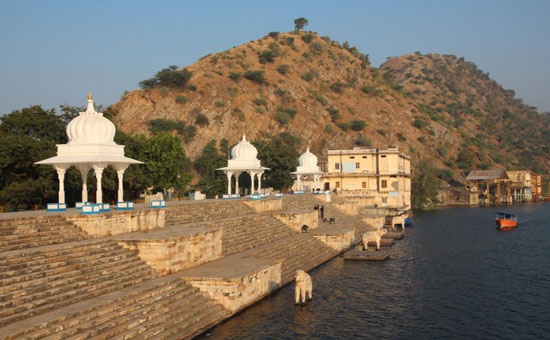 Lake Bank. Early morning.
Lake Bank. Early morning.
On May 22 1691 CE, Maharana
Jai Singhji laid the foundation of the lake and the occasion was celebrated by
donating gold after a tula-daan. The dam also houses Narmdeshwar Shiva temple,
the construction of which was started by Maharana Jai Singhji but he could not
complete it during his lifetime. Seeing the deluge of
CE.1875 Maharana
Sajjan Singhji, (ruled 1874 – 1884) spent Rupees 2 lakh to fill just
about 2/3rd of the vast area between the two dams with stone, mud and lime. The
hill to the south of the dam was dotted with Palaces of Maharana Jai Singhji
which were later restored by Maharana Sajjan Singhji. With dense forest area
all around it, Jaisamand is an enormous, charismatic lake.
Thur Talab (Pond) Maharana Jai Singhji got Thur Talab constructed near village Thur, approximately 5 miles northwest of Udaipur. The foundation of this talab was laid in 1687 CE.
Today the lake provides drinking water to Udaipur and is used for irrigation also. So what was made around 1686 continues to be useful even 330 years later.
4. Lake Pichola built by Maharana Lakshya Singh, ruled
1382-1421.
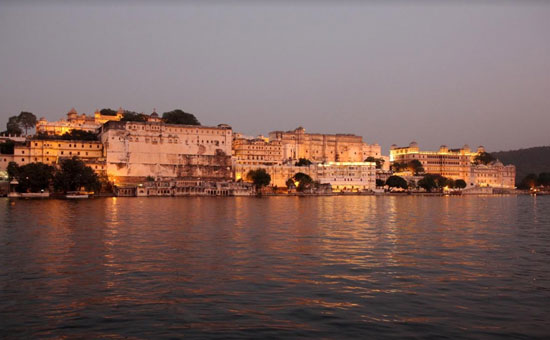 Sunset view Lake Pichola, behind City Palace.
Sunset view Lake Pichola, behind City Palace.
Approximately
625 years ago, between 1383-85, Maharana Lakha, ruled 1382-1421, (Lakshya
Singh) got a lake constructed by getting a temporary dam built between Machala
Magra and Rana Magri, (on the hill on which present day City Palace is built).
Lake
Pichola got its name from a nearby village, Picholi.
Later
Maharana Udai Singhji was instrumental in providing it a grand look by
replacing the ordinary, temporary structure with a more concrete one. The bank
of the lake is dotted with beautiful temples, bridges, old ‘havelis’ (mansions) and the magnificent
City Palace.
When
this dam collapsed in 1795 Maharana Bhim Singhji, ruled 1778-1828, got it
repaired in a much sturdier manner for it to withhold floods in the future.
Glorious structures such as Jagmandir and Jagniwas stand tall within this lake.
The
lake was further strengthened and beautified by Maharana Jawan Singhji, ruled
1828-1838, and Maharana Swarup Singhji, ruled 1842-1861, during their
respective reigns making it world famous for its beauty and strength.
To the
east of Lake Pichola is Doodh Talai, a small
pond which was constructed to meet the water requirement of animals of a Banjara, a trader.
Today it presents itself as a renowned tourist spot.
In 1668
Maharana Raj Singhji I established Lake Rang Sagar in memory of his son Rajkumar
Sultan Singhji ‘Surtran’. Foundation of Rang Sagar
was laid by Kunwar Jai Singhji, currently it is part of Lake Pichola.
Udaipur
city was founded by Maharana Udai Singhji II during his reign when Kumariya Talab was also created for the Kumhar
community, (makers of bricks and earthen pots).
During Maharana
Sajjan Singhji’s regime in 1874 it was connected with Lake Rang Sagar.
Similarly Maharana Sajjan Singhji, in the year 1874, got two ponds-Pond Kumariya
and Pond Amar Kund – which were constructed
during the reign of Maharana Ari Singh, ruled 1761-1773, merged into Lake Rang
Sagar thus expanding and giving it a grand form.
5. Jana Sagar built in 1668 CE by Maharana Raj Singhji I.
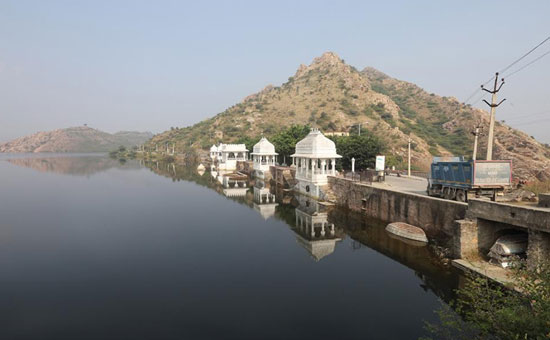
The
Maharana got this water body created in village Badi situated 10 Kms away to
the west of Udaipur in memory of his mother Rajmata Janade (Karmitiji).
The
primary reason for the creation of this water body was to meet the irrigation
requirement of village Badi and other close by villages as well as to ensure that
Lake Fateh Sagar and Lake Dewali would have adequate water all year round. This
dam was strong enough to withstand the floods of 1795.
A silver
tula-daan was performed during the creation of this lake and priest Garibdas
was gifted village Gunhand (Gilund) and Depura. Rs. 6,88,000 was the total
expenditure on the construction of this water body. Name of architect for this lake was Jassa.
The farsightedness of Maharana Raj Singh I.
Maharana
Raj Singh I pioneered the technique of changing the course of water flow to
give it a permanent form. The course of water flow of River Obey Var flowing from
Ubeshwar, the famous pilgrim site of Mewar was turned to join River Morwani
between the years 1652-80. Thus, this water started entering Lake Jana Sagar
and Lake Fateh Sagar. Prior to this water from River Ubeshwar would enter Lake
Chota Madar.
The 350 year old dam created on this river is still functional.
Lake Swarup Sagar
Constructed
during the reign of Maharana Swarup Singhji, this lake is situated in place of
Kalalya Shivsagar Pond, which was named after the Shiv temple of Kalal
community.
In the
year 1845 Maharana Swaroop Singhji gave this pond the form of a lake and so it
came to be known as Swarup Sagar.
Swarup
Sagar is interconnected with Lake Pichola, Lake Rang Sagar and Lake Kumariya.
6. Lake Fateh Sagar built by Maharana Fateh Singhji, ruled 1884-1930.
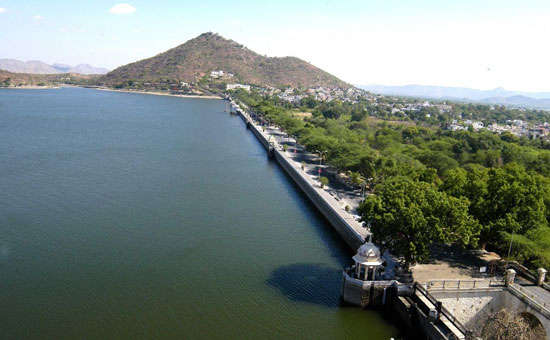
Approximately
1.5 miles north of Udaipur was a small pond called Dewali ka Talab, built by
Maharana Jai Singhji. It derived its name from village Dewali where it was
initially constructed by Maharana Jai Singhji in the year 1680. The dam on this
pond was not very high.
During
the reign of Maharana Bhim Singhji the earthen dam got washed away in floods;
later in 1889 Maharana Fateh Singhji, got it restored and renovated to form a
lake. Its foundation was laid by Prince Arthur, Duke of Connaught and
Strathearn, Commander of The Bombay British Army, and the third son of Queen
Victoria, hence it was originally named Connaught dam. Later the Duke suggested
that the enlarged and restored water reservoir be called Fateh Sagar hence the
lake was renamed Fateh Sagar.
Prior
to the construction of Jana Sagar (Badi Lake) water from river Morwani would
flow into Fateh Sagar; because of Jana Sagar the lake was and continues to be
fed by river Hathi Dhara and Chikalwas canal that overflows to Jana Sagar
enters Fateh Sagar. Apart from this, the overflow of Lake Pichola is diverted into
Rang Sagar and Swarup Sagar and the overflow of these two lakes is further
directed through a controlled inlet canal that leads to Lake Fateh Sagar. The
same Dewali Talab is now popularly known as Lake Fateh Sagar.
Chikalwas Feeder Canal
A dam
was constructed to the west of Udaipur near village Chikalwas, on river Ayed
along with a feeding canal to link it with Lake Fateh Sagar to ensure adequate
water supply to the lake.
During
monsoons the overflow of Ayed River is diverted through this canal into Lake
Fateh Sagar.
This
canal was constructed during in 1890 during the reign of Maharana Fateh Singhji.
On August 13, approximately 129 years back, history was created by Maharana
Fateh Singhji by diverting water into Chikalwas feeder canal and this plan is
now referred to as - ‘The world’s first
river linking project’. The Engineer in the service of Mewar then was Mr.
Campbell Thompson.
Thus, Mewar
was then the only state in the world to display examples of inter-linkage of
lakes and inter connection and diversion of rivers.
Lake Govardhan Sagar
In 1857
Maharana Swarup Singhji got a lake and a cowshed constructed approximately 3
kms west of Lake Pichola. The same reign saw the replacement of rock walls by a
gate that led Lake Govardhan to join Lake Pichola.
Indra Sarovar
Maharana
Mokal, ruled 1421-1433, got Indra Sarovar at Eklingnathji renovated and restored.
In order to beautify it Maharana Raj Singhji I got the dilapidated Indraser (Indra
Sarovar) dam replaced with a new dam. The water from this lake has forever been
used for the worship of the supreme Deity of Mewar, Shree Eklingnathji.
7. Baghela Talab
Situated
in the southwest corner of Shree Eklingnathji temple, the Baghela Talab was
constructed by Maharana Mokal in memory of his brother Badh Singh.
Conclusion
The
incredible strategic micro-management of creation, expansion, preservation,
direction of water bodies by the Maharanas of Mewar has taken the world by
surprise.
Confined
to merely 470 kms, the small Girwa valley boasts of systematic inter-connection and inter-linking of
various rivers and water bodies by the then
Maharanas.
This is considered to be the best example of using available
local water resources to systematically conserve and manage rain water.
Since
the past 600 years Maharanas of Mewar have continuously demonstrated before the
world the importance of water conservation by implementing their traditional techniques
of water conservation by using their self-created water bodies which are still
the matchless water reservoirs of effective and successful ways of water
harvesting and harnessing.
The concept
of changing the course of a flowing river by Maharana Raj Singhji I and merging canals with rivers by Maharana
Fateh Singhji can be used as examples for water bodies across India to tackle
the future water crisis of the country.
Apart
from the above mentioned world famous lakes, Maharanas of Mewar have been
pioneers in the creation of various water projects such as - dams, wells, step-wells,
ponds and lakes. Small and big water reservoirs
such as - Heera Talai, Dewali Talab, Khemli Talab, Chota Madar, Bada Madar, Nela
Talab, Rundela Talab and Roop Sagar have been important sources of drinking
water and irrigation, spread across the region of Mewar. Currently in the race
for development, many of these water bodied have either already lost their
existence or are on the verge of extinction.
“The
greatest need of the hour is proper management and adequate conservation of
water. If the present scenario continues it can eventually lead to the
compulsion of importing water in future. Inter-connection of rivers cannot be
the only alternative to meet water
scarcity. Each one of us will individually have to take responsibility and
inculcate the habit of ensuring creative ways for sustainable management of available natural resources of fresh water.
The ultimate need of the nation is - Water Justice.”- Arvind Singh Mewar
Article by Maharana Mewar Historical Publication
Trust, City Palace, Udaipur, Rajasthan. Pictures 3, 3a and 4 by Sanjeev Nayyar, rest by author.
References
1. Vir
Vinod
2.
Udaipur Rajya ka Itihaas
3. Raj
Prashasti Mahakavyam
Also
see
1. Pictures of
Jaisamand Lake
2. Water
system Hampi
3. Traditional
forms of water harvesting
4. Naul
and Dhar – water conservation in the Himalayas
5. Step-wells India